I’ve received too many DMs, emails, and texts over the weekend to not talk about the… I don’t even know what to call it… temporary insurrection? Got cold feet attempted coup? “I’m going to overthrow the power structures within Russia, J/K, I’ll see myself out now mkay, bye” Kabuki theater performed by Prioghzin?
But before we discuss the disintegration of a former “Superpower” that we’re all bearing witness to, I’m going to first plainly and quickly lay out why I have been, and continue to be, an ardent supporter of Ukraine and their fight against Russia for national autonomy and why I think it’s imperative that the West does even more in supporting their defense efforts.
I’ve had a number of sidebar conversations about this with Macro Ops members since the invasion. And I recognize that there are quite a few who disagree with my position. So I only think it fair to share where I stand with the whole group, so you understand where I’m coming from, and why I have the biases I do.
Survival: Rising Systemic Risks Demands Expanding Democracy
Our entire much-praised technological progress, and civilization generally, could be compared to an axe in the hand of a pathological criminal. ~ Albert Einstein
After the advent of the nuclear bomb, a technology that Einstein’s foundational work made possible, he wrote to a friend that “Our world faces a crisis as yet unperceived by those possessing power to make great decisions for good or evil. The unleashed power of the atom has changed everything save our modes of thinking and we thus drift toward unparalleled catastrophe.”
We are a world of 8 billion people. This world is more crowded than ever. We’re more connected than ever. And our technological ability to annihilate ourselves is greater than ever.
It’s not just nukes. It’s the AI-enabled creation of new bio and chemical weapons (link here).
It’s the nearly impossible to intersect hypersonic delivery systems capable of carrying nuclear warheads (link here).
It’s a single cyber attack that can cause damage on a national and even global scale (link here).
It’s the AI-enabled costless and limitless flooding of our information/news spheres, making mincemeat of our collective abilities to understand truth, effectively communicate, and solve problems (link here).
The list goes on and on… To again quote Albert, it is “appallingly obvious that our technology has exceeded our humanity.”
It is a dangerous world we live in. It’s a MUCH more dangerous world we’re moving into.
And because our technology evolves exponentially faster than our consciousness expands, it is imperative that we globally trend towards systems of governance that promote collective rule, transparency, and checks and balances on those in positions of power.
Currently, the best system we have for this is democracy.
Even the flavor of democracy we currently practice here in the States, with all its hair and many shortcomings … it’s still infinitely preferable from the point of ensuring human survival, than those which are now in place in countries like Russia, China, or North Korea… countries where a single man can direct the full destructive capacities of his nation onto the world completely at his whim.
Think about it, the risks of a mad King spilling his venom onto the globe have been localized for the entirety of mankind.
He was limited by the range in which his artillery could fire and by the speed at which his ground army could advance. The “Scourge of God” himself, Attila the Hun, could only rape and pillage as far and as fast as his hoofed horde could roam.
And this has been true for all of history, at least up until WW2, which is only 70 years and some change ago.
Our technological “advancement” means that the most threatening self-inflicted localized risks that humanity has routinely faced since time immemorial have today become systemic threats to our species’ survival.
A quick example…
Ivan the Terrible, the 16th-century Tsar of Russia, was a man worthy of his name.
His paranoia and collapsing mental health later in life meant he and his nation’s resources, which he fully controlled, acted as a plague against his own people as well as the entire Eastern European Plain.
Vladimir Putin too completely controls his nation’s resources. Unlike Ivan, Vlad isn’t limited by geography or scope in the scourge he can inflict upon the world. We also know that he too is becoming increasingly isolated, paranoid, and demented (read this account from Karakulov, a Captain in Putin’s personal security detail who defected to the West last October).
For well over a decade now, Putin has been carrying out active and increasingly aggressive measures against Western countries for the sole purpose of sowing chaos and disruption.
Because his rotting kleptocracy cannot compete economically with free democratic societies, he seeks to bring them down to his level by infecting them like a cancer.
He accomplishes this through numerous means (cutting vital subsea internet cables, creating large orbital debris fields so as to deny the West easy access to space, jamming up Western online communication with disinformation so as to sow distrust and discontent, placing nuclear weapons in the center of Europe, attempting to assassinate Western citizens on Western soil, constant cyberattacks against both public and private interests such as NotPetya, the most costly cyberattack in history…).
The list goes on and on…
And honestly, I can tell you as someone who used to work the Russia desk within the USIC, Putin’s most aggressive acts haven’t seen the light of day, for reasons I’ve never been able to comprehend other than that if the public knew everything his regime had done and was doing, they’d want a much more aggressive US retaliatory response.
And if you’ve followed the US’s handling of Russia over the past 15 years then you know it’s been complete laissez-faire. Annoyance overwhelmed by disinterest like a giant occasionally swatting at a persistent fly.
We were under the impression the Cold War ended when the walls came down, but Putin had other plans and we’re just now waking up to this truth.
This lack of strategic geopolitical cohesion from the West, and the US in particular, is largely why Putin became so emboldened over the years.
But I digress…
The truth is it’s irrelevant which authoritarian leader we’re talking about. Putin could be replaced by another, and the systemic risks of having a single person ruling with total control, in charge of the world’s largest nuclear weapons stockpile, is too systemic a risk to be ignored or allowed in our age.
Democratic Peace Theory
Under a non-republican constitution, where subjects are not citizens, the easiest thing in the world to do is to declare war. Here the ruler is not a fellow citizen, but the nation’s owner, and war does not affect his table, his hunt, his places of pleasure, his court festivals, and so on. Thus, he can decide to go to war for the most meaningless of reasons, as if it were a kind of pleasure party…
~ Immanuel Kant, Perpetual Peace and Other Essays
The fact that democracies are much less likely to go to war with one another has been widely researched and is well supported.
The democratic peace dividend can be quite easily seen in the data. Below is a chart showing the percentage of years in which ‘Great Powers’ fought one another, from 1500-2015.
We can see that prior to the 18th-century reincarnation of democracy, wars between major powers were a near constant but have since become a rarity.
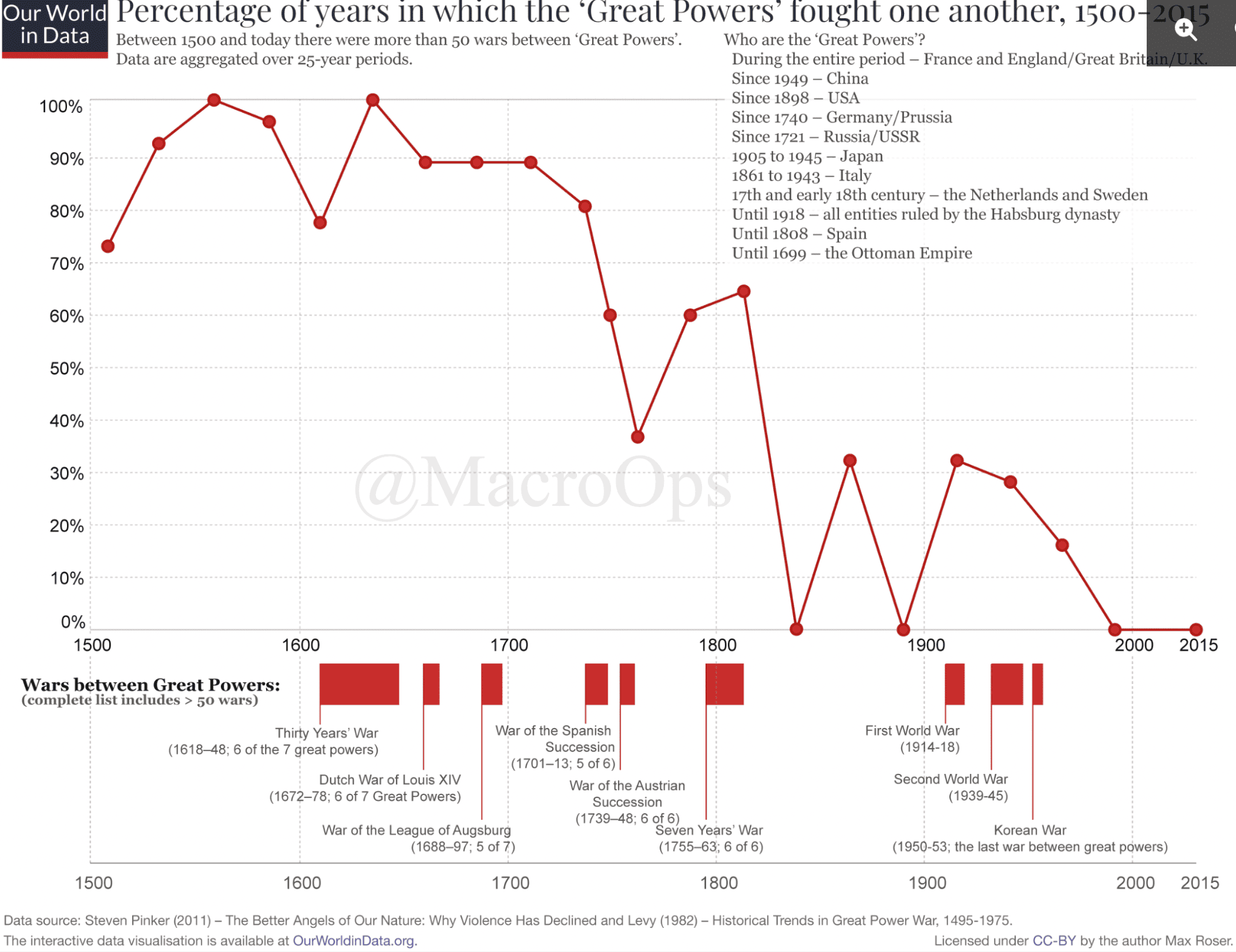
And while there are no doubt other factors at play (ie, role of deterrence due to scale and scope of weapons, increasing global economic linkages, improved cross-border communications, etc…), the rise of democracies as a form of government has certainly played a significant role in this decline.
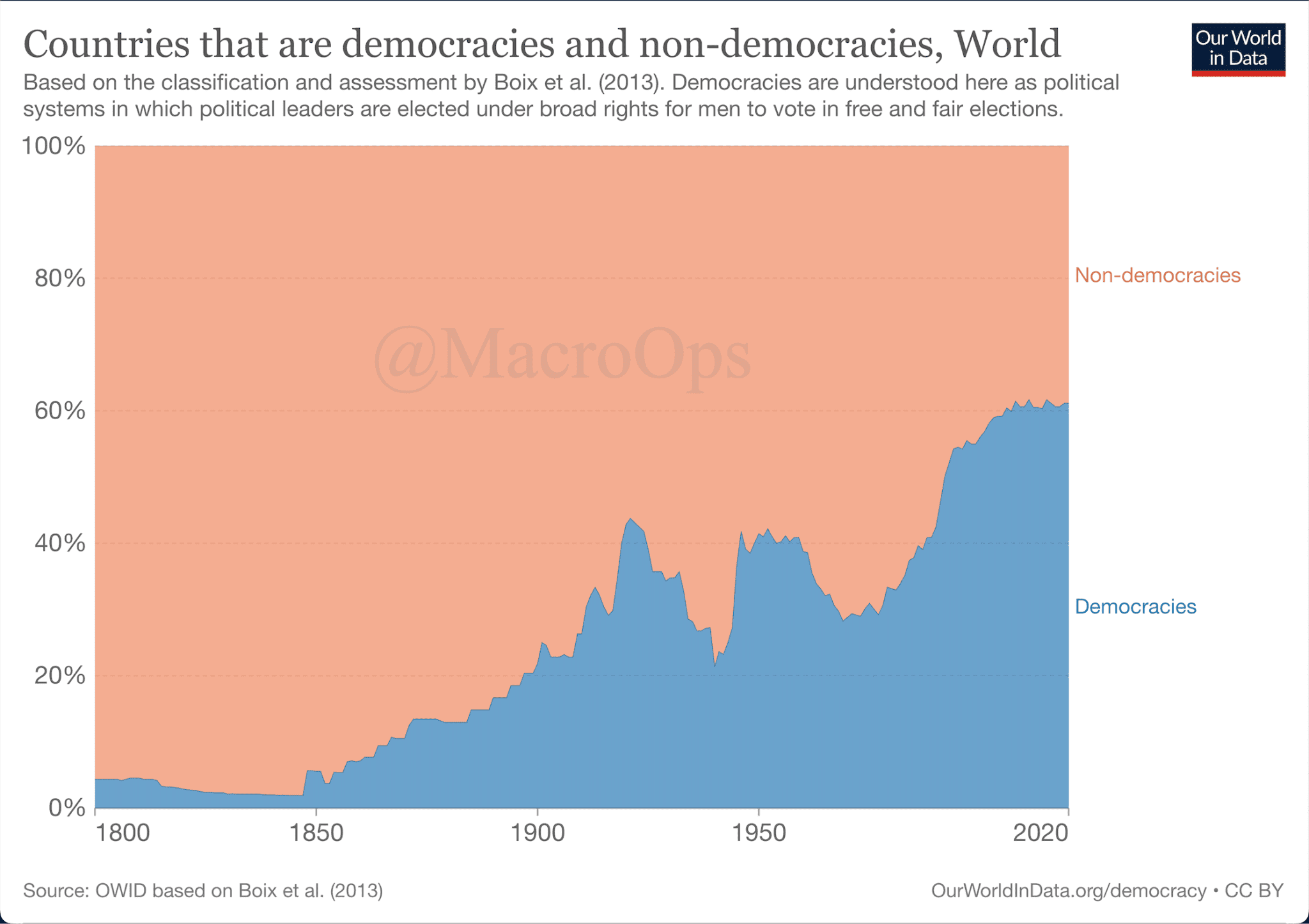
But while democracies have helped limit large-scale conflict between major powers, the exponential rise in the sheer destructive power of our weapons has raised the lethality of our conflicts.
The graph below charts the deaths in conflicts since 1400. Each red circle represents one conflict. The size of the circle represents the number of fatalities (both military and civilian). The position on the y-axis represents the fatality rate per 100,000 people. And the red line illustrates the 15-year moving average of the total death rate.
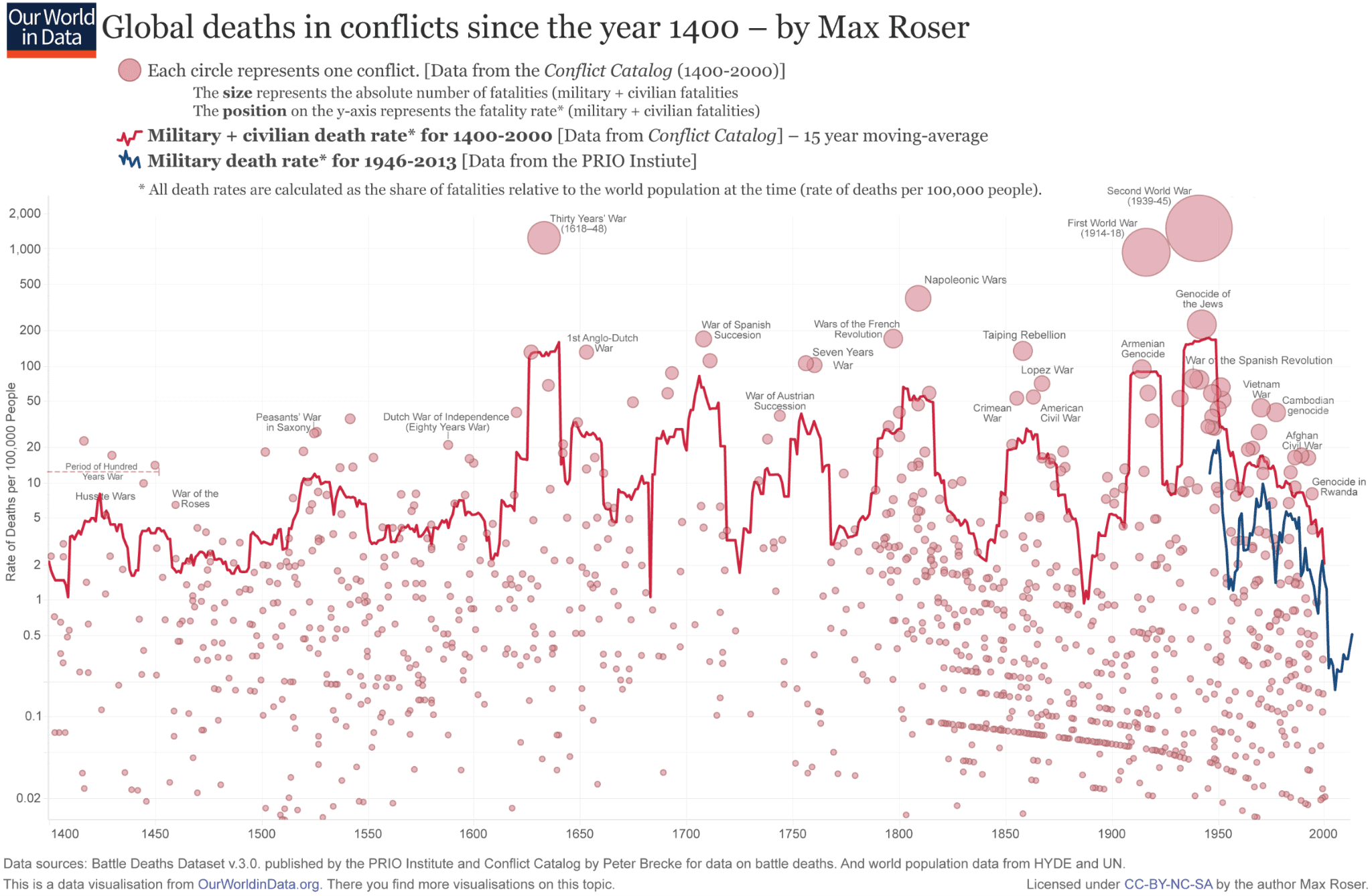
A few things stand out about this chart.
One is the clear cyclicality of the total conflict death rate, which becomes most apparent from the start of the 17th century onward and appears to move in 50 to 75-year cycles giving credence to Dalio’s idea of Long-term Debt Cycles driving geopolitical variance — if history is a guide then we’ve entered the era in which we’d expect another significant spike in deaths attributed to conflict.
The other is that conflicts have gotten significantly more lethal over the last hundred years, as clearly shown by the two largest dots representing the First and Second world wars. Two wars started by monarchs and authoritarians.
The red trend line would be significantly below the historical range if not for these wars.
It’s for the above reasons that I find the data below so troublesome.
This graph shows the “Democracy Gap”. The red bars represent the difference in the number of countries with improving democracy scores versus those with declining ones.
As we can see, there’s been an accelerating trend towards autocracy over the past 18 years now.
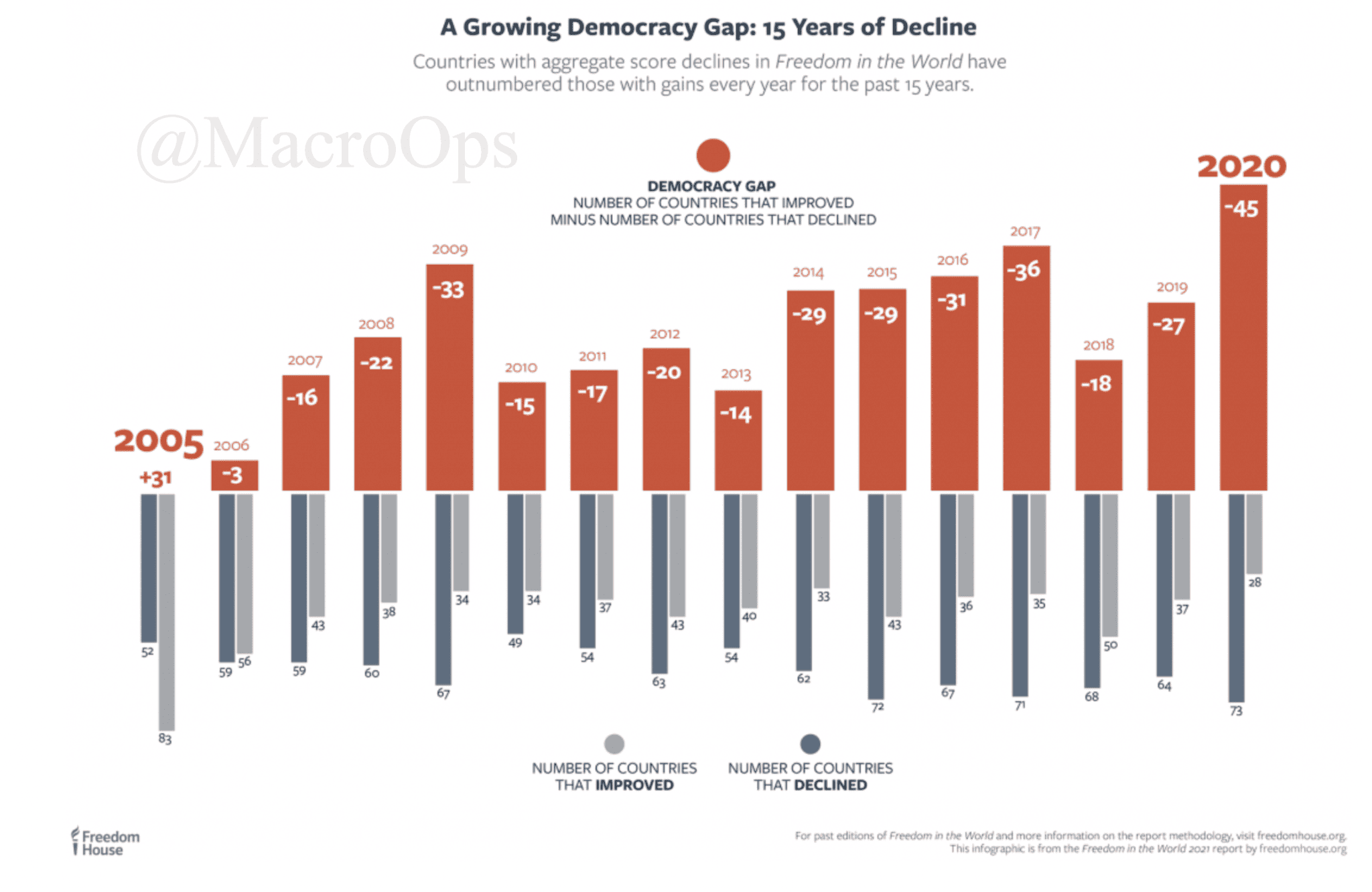
Here’s another illustration of this trend.
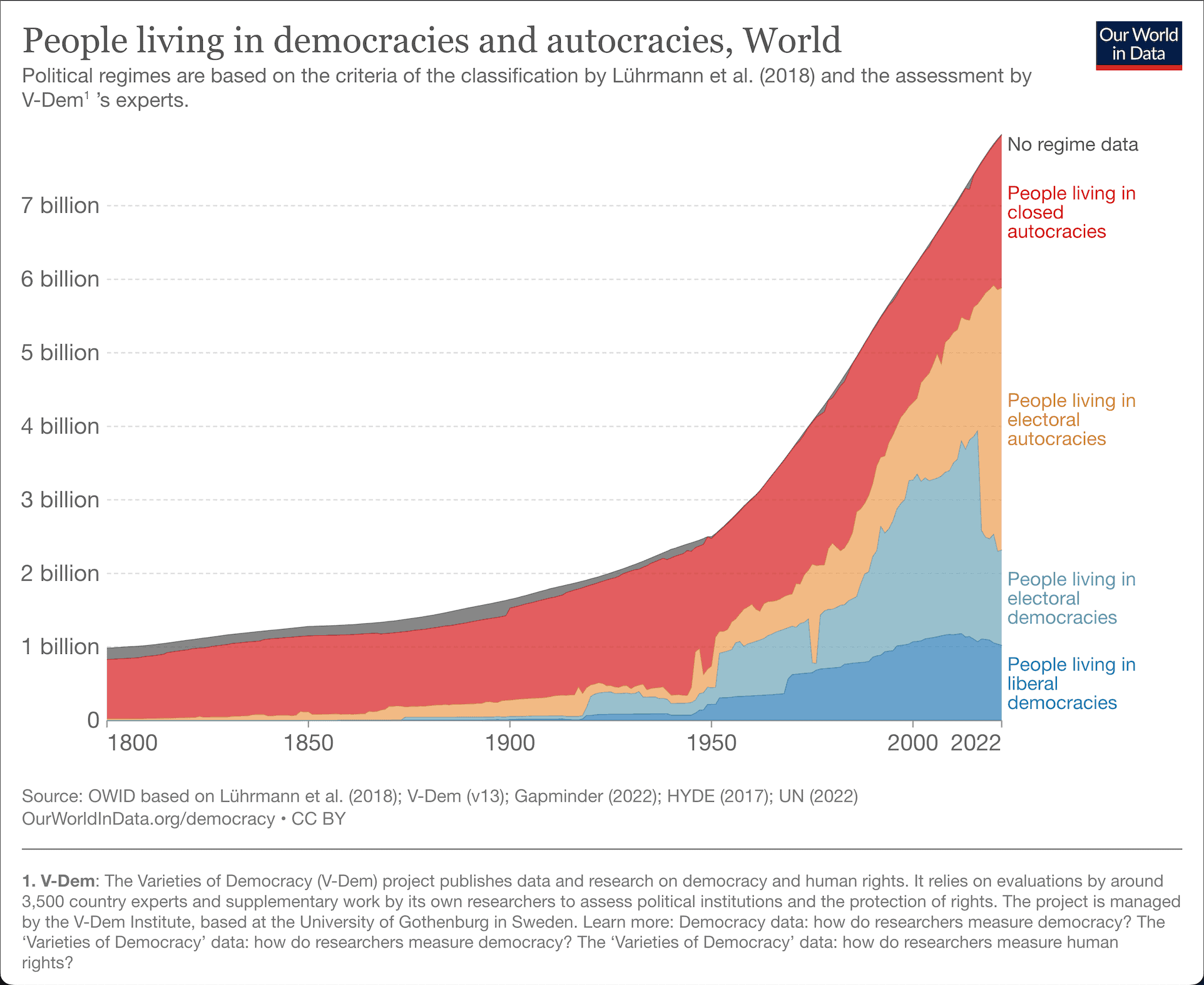
If left unchecked then this trend combined with our increasingly lethal technologies nearly ensures the extinction of the human race at some point. That’s not hyperbole, it’s a logical probability.
If a growing number of countries with increasingly destructive weaponry are ruled by sociopathic narcissists who possess total control over said weapons and their use, then it’s only logical to assume that those weapons will be increasingly used. And we don’t need more nukes in the hands of pathological criminals, to paraphrase Einstein again.
This is the philosophical reason why I strongly support Ukraine’s right to exist, free of Russian (Putin’s) control.
It’s why I strongly support their efforts of democratic establishment. It’s why I think it’s imperative that liberal democracies the world over work in greater cooperation to positively incentivize and peacefully coerce those nations which fall under authoritarian rule. And, also, to occasionally but powerfully act as bulwarks when their international transgressions risk disrupting a free and democratic state, as is now the case.
I believe this will be the pressing theme of our time. Currently, it’s Russia and Ukraine. Next, it will be China and Taiwan. How we collectively act now in support of Ukraine will greatly influence Xi’s future plans concerning Taiwan.
Thank you for attending my Ted Talk.
Whiskey Tango Foxtrot over?
Okay, let me step down from my soapbox and explain quickly what happened over the weekend. And unfortunately, it’s not anything as exciting as many of the daft theories I’ve seen being tossed around.
My favorite one is that this was all a false flag planned by both Putin and Prigozhin for reasons that are completely unclear…
I spent the weekend talking with old intel buddies and here’s the gist of what they told me. And, of course, the usual caveat, this is all non-classified open-source stuff. It’s not like I have any secrets to share.
Okay, so we knew Prigozhin was planning something as far back as Spring. This wasn’t just a knee-jerk insurrection due to the June 10th order from Shoigu that Wagner soldiers would have to sign contracts with his ministry, as many believe.
This operation ran pretty damn smoothly. Wagner’s forces were able to move men, APCs, and tanks from Ukraine to within 200km of Moscow in under 24hrs. This also included taking control of Russia’s major southern military and logistics hub, Rostov-on-Don. No small feat.
So no way in hell was this some seat-of-the-pants operation. Prigozhin was gunning for something and by all measures that something appears to be a coup and unseating his old pal Putin.
Prigozhin and his Wagner Group had been running an increasingly rebellious propaganda machine over the past year.
This started with complaints against the MoD that his men weren’t receiving proper supplies. It then escalated to outright attacks against the top military brass and finally culminated last week with a speech plainly calling BS to every excuse Putin had given to the public about why Russia had no choice but to invade Ukraine.
Not to mention, Prigozhin has been ever eager — and quite social media savvy — at highlighting his leadership and Wagner’s superior combat record compared to that of the regular military. You don’t put in that kind of effort unless you have grander plans.
So why did he stop?
Why did he order his men to stand down and about-face, after committing unforgivable treason, especially considering they shot down six helicopters and an Il-18 command and control aircraft, killing as many as 13 of their very own countrymen in the process?
The true but unsatisfying non-galaxy brain answer is just that Prigozhin lost his nerve… and so did Putin.
The word is that Prigozhin was hoping for his rebellion to spark a more general uprising, both amongst the populace as well as parts of the military. And that he could then ride this support to Moscow and a quick, preferably bloodless, transition of power.
But while he was met with lots of cheers and fanfare among both when he road into Rostov-on-Don. This enthusiasm coupled with the broadly shared dislike for Putin was ultimately overwhelmed by an even more powerful general apathy amongst the Russian people, who just don’t care to be bothered.
This gave Priogzhin cold feet.
Meanwhile, Putin fled Moscow to one of his “safe places” by plane as soon as Wagner crossed the Russian border. Though his Praetorian Guard numbers roughly 10,000. It’s unlikely this force possessed the firepower, let alone the willingness to take on Wagner (it should be noted that the Wagner Group is quite respected and glorified amongst Russians).
Putin knew this and so didn’t dare risk directly confronting Prigozhin and his men. Instead, he tucked tail and pleaded to his Belarusian puppet Lukashenko to broker a deal between the two.
The entire affair was really a 21st-century idiots version of Julius Caesar advancing his Thirteenth legion to Rimini and crossing the river Rubicon, officially sparking Rome’s Second Civil War.
But, alea jacta est (the die has been cast), this was not.
Cause instead of brave men of history throwing down the gauntlet thus giving their lives over to Fait, we got two inept nutless scumbags who saw the slightest risk to their persons and turned and ran…
Anyways… what are the consequences and what does this mean going forward?
First, Prigozhin has a painted target on his head. The FSB will certainly be gunning to make another Litvinenko of him. He knows this so he either goes into hiding (good luck with that) or we see him again in the near future with another maybe more coordinated coup attempt.
Prigozhin also really bent his own guys over a barrel. Every Wagner soldier that participated in the coup now also has numbered days. Word is that more than a few of his own men want his head.
As for Putin, this whole event is devastating. The number one rule of strong-man dictatorships is that you must appear strong. There’s no amount of shirtless horseback riding he can do at this point that’s going to restore him to his former standing. That cheap veneer is completely off.
Putin is now more terrified for his life.
The fact that this well-planned sizable coup was allowed — and yes, it was allowed — by members and organizations under his “control”, has to scare the Pechenye Yablokis out of him.
Surely members of the FSB or at the very least the GRU knew of Prigozhin’s plan. Yet, not a single mention of it ever made its way to the man at the top. Who amongst his top brass knew? Better yet, who supported or colluded?
These questions will be plaguing Vlad’s little bald head for the foreseeable future. I’d say the odds favor a Great Purge but I don’t believe he has the power to order such a thing at this point.
Realistically, Putin’s days are likely numbered. His dominoes of complete and utter strategic and domestic failures over the past 14 months have put him in a hole that’s likely too deep to ever claw out of.
Russia is a country in the early stages of total collapse. The morale there is as bad or worse than it was in the 90s when Putin opportunistically wielded the prevailing chaos to weasel his way to power. Western countries are going to be even more emboldened in supporting Ukraine after this weekend’s events.
In order to further protect his own hide I imagine we’ll see him remove some units from Ukraine and station them domestically in order to prevent a part deux.
And lastly, imagine what this does to the Russian military’s morale, which was already in the pits. They just saw one of the war’s most visible and respected leaders call out the lies given for the war in which they’re being asked to risk their lives. And then turn on their own commander-in-chief, who feebly asked the insurrectionist to please leave.
That is devastating… Eisenhower said “morale is the single greatest factor in successful wars” for good reason. This is true even when your main strategy is throwing young men into the meat grinder. You still need some semblance of shared belief and purpose or else command falls apart, and soldiers push back.
The coming six months are going to be very interesting in how this grand play of misery pans out. There are lots of variables, lots of potential paths forward. To quote Homer “I know not what the future holds, but I know who holds the future” and it’s not Putin nor men like him…










